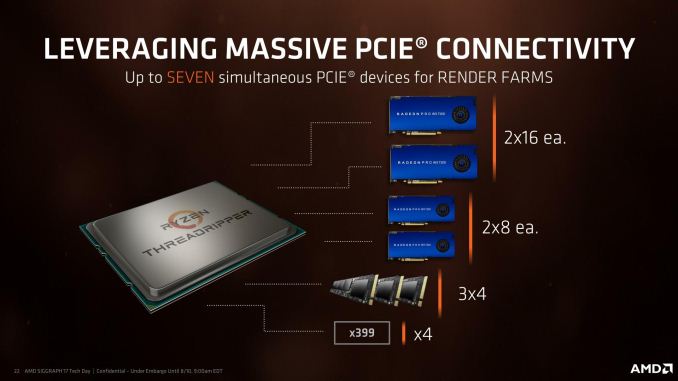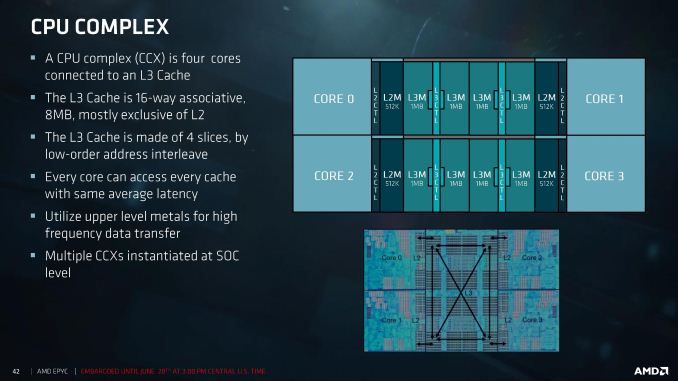The AMD Ryzen Threadripper 1950X and 1920X Review: CPUs on Steroids
by Ian Cutress on August 10, 2017 9:00 AM ESTFeeding the Beast
When frequency was all that mattered for CPUs, the main problem became efficiency, thermal performance, and yields: the higher the frequency was pushed, the more voltage needed, the further outside the peak efficiency window the CPU was, and the more power it consumed per unit work. For the CPU that was to sit at the top of the product stack as the performance halo part, it didn’t particularly matter – until the chip hit 90C+ on a regular basis.
Now with the Core Wars, the challenges are different. When there was only one core, making data available to that core through caches and DRAM was a relatively easy task. With 6, 8, 10, 12 and 16 cores, a major bottleneck suddenly becomes the ability to make sure each core has enough data to work continuously, rather than waiting at idle for data to get through. This is not an easy task: each processor now needs a fast way of communicating to each other core, and to the main memory. This is known within the industry as feeding the beast.
Top Trumps: 60 PCIe Lanes vs 44 PCIe lanes
After playing the underdog for so long, AMD has been pushing the specifications of its new processors as one of the big selling points (among others). Whereas Ryzen 7 only had 16 PCIe lanes, competing in part against CPUs from Intel that had 28/44 PCIe lanes, Threadripper will have access to 60 lanes for PCIe add-in cards. In some places this might be referred to as 64 lanes, however four of those lanes are reserved for the X399 chipset. At $799 and $999, this competes against the 44 PCIe lanes on Intel’s Core i9-7900X at $999.
The goal of having so many PCIe lanes is to support the sort of market these processors are addressing: high-performance prosumers. These are users that run multiple GPUs, multiple PCIe storage devices, need high-end networking, high-end storage, and as many other features as you can fit through PCIe. The end result is that we are likely to see motherboards earmark 32 or 48 of these lanes for PCIe slots (x16/x16, x8/x8/x8/x8, x16/x16/x16, x16/x8/x16/x8), followed by a two or three for PCIe 3.0 x4 storage via U.2 drives or M.2 drives, then faster Ethernet (5 Gbit, 10 Gbit). AMD allows each of the PCIe root complexes on the CPU, which are x16 each, to be bifurcated down to x1 as needed, for a maximum of 7 devices. The 4 PCIe lanes going to the chipset will also support several PCIe 3.0 and PCIe 2.0 lanes for SATA or USB controllers.
Intel’s strategy is different, allowing 44 lanes into x16/x16/x8 (40 lanes) or x16/x8/x16/x8 (40 lanes) or x16/x16 to x8/x8/x8x8 (32 lanes) with 4-12 lanes left over for PCIe storage or faster Ethernet controllers or Thunderbolt 3. The Skylake-X chipset then has an additional 24 PCIe lanes for SATA controllers, gigabit Ethernet controllers, SATA controllers and USB controllers.
Top Trumps: DRAM and ECC
One of Intel’s common product segmentations is that if a customer wants a high core count processor with ECC memory, they have to buy a Xeon. Typically Xeons will support a fixed memory speed depending on the number of channels populated (1 DIMM per channel at DDR4-2666, 2 DIMMs per channel at DDR4-2400), as well as ECC and RDIMM technologies. However, the consumer HEDT platforms for Broadwell-E and Skylake-X will not support these and use UDIMM Non-ECC only.
AMD is supporting ECC on their Threadripper processors, giving customers sixteen cores with ECC. However, these have to be UDIMMs only, but do support DRAM overclocking in order to boost the speed of the internal Infinity Fabric. AMD has officially stated that the Threadripper CPUs can support up to 1 TB of DRAM, although on close inspection it requires 128GB UDIMMs, which max out at 16GB currently. Intel currently lists a 128GB limit for Skylake-X, based on 16GB UDIMMs.
Both processors run quad-channel memory at DDR4-2666 (1DPC) and DDR4-2400 (2DPC).
Top Trumps: Cache
Both AMD and Intel use private L2 caches for each core, then have a victim L3 cache before leading to main memory. A victim cache is a cache that obtains data when it is evicted from the cache underneath it, and cannot pre-fetch data. But the size of those caches and how AMD/Intel has the cores interact with them is different.
AMD uses 512 KB of L2 cache per core, leading to an 8 MB of L3 victim cache per core complex of four cores. In a 16-core Threadripper, there are four core complexes, leading to a total of 32 MB of L3 cache, however each core can only access the data found in its local L3. In order to access the L3 of a different complex, this requires additional time and snooping. As a result there can be different latencies based on where the data is in other L3 caches compared to a local cache.
Intel’s Skylake-X uses 1MB of L2 cache per core, leading to a higher hit-rate in the L2, and uses 1.375MB of L3 victim cache per core. This L3 cache has associated tags and the mesh topology used to communicate between the cores means that like AMD there is still time and latency associated with snooping other caches, however the latency is somewhat homogenized by the design. Nonetheless, this is different to the Broadwell-E cache structure, that had 256 KB of L2 and 2.5 MB of L3 per core, both inclusive caches.












347 Comments
View All Comments
drajitshnew - Thursday, August 10, 2017 - link
You have written that "This socket is identical (but not interchangeable) to the SP3 socket used for EPYC,".Please, clarify.
I was under the impression that if you drop an epyc in a threadripper board, it would disable 4 memory channels & 64 PCIe lanes as those will simply not be wired up.
Deshi! - Friday, August 11, 2017 - link
No AMD have stated that won;t work. Its probably not hardware incompatible, but they probably put microcode on the CPUS so that if it doesn;t detect its a Ryzen CPU it doesn't work. There might also be differences in how the cores are wired up on the fabric since its 2 cores instead of 4. Remember, Threadripper has only 2 Physical Dies that are active. on Epyc all processors are 4 dies with cores on each die disabled right down to the 8 core part. (2 enabled on each physical die)Deshi! - Friday, August 11, 2017 - link
Wish there was an edit function..... but to add to that, If you pop in an Epyc processor, it might go looking for those extra lanes and memory busses that don;t exist on Threadripper boards, hence cause it not to function.pinellaspete - Thursday, August 10, 2017 - link
This is the second article where you've tried to start an acronym called SHED (Super High End Desktop) in referring to AMD Threadripper systems. You also say that Intel systems are HEDT (High End Desktop) when in all reality both AMD and Intel are HEDT. It is just that Intel has been keeping the core count low on consumer systems for so long you think that anything over a 10 core system is unusual.AMD is actually producing a HEDT CPU for $1000 and not inflating the price of a HEDT CPU and bleeding their customers like Intel was doing with the i7-6950X CPU for $1750. HEDT CPUs should cost about $1000 and performance should increase with every generation for the same price, not relentlessly jacking the price as Intel has done.
HEDT should be increasing in performance every generation and you prove yourself to be Intel biased when something finally comes along that beats Intel's butt. Just because it beats Intel you want to put it into a different category so it doesn't look like Intel fares as bad. If we start a new category of computers called SHED what comes next in a few years? SDHED? Super Duper High End Desktop?
Deshi! - Friday, August 11, 2017 - link
theres a good reason for that. Intel is not just inflating the cost because they want to. It literally cost them much more to produce their chips because of the monolithic die aproach vs AMDs Modular aproach. AMDs yeilds are much better than INtels in the higher core counts. Intel will not be able to match AMDs prices and still make significant profit unless they also adopt the same approach.fanofanand - Tuesday, August 15, 2017 - link
"HEDT CPUs should cost about $1000 "That's not how free markets work. Companies will price any given product at their maximum profit. If they can sell 10 @ $2000 or 100 at $1000 and it costs them $500 to produce, they would make $15,000 selling 10 and $50,000 selling 100 of them. Intel isn't filled with idiots, they priced their chips at whatever they thought would bring the maximum profits. The best way for the consumer to protest prices that we believe are higher than the "right" price is to not buy them. The companies will be forced to reduce their prices to find the market equilibrium. Stop complaining about Intel's gouging, vote with your wallet and buy AMD. Or don't, it's up to you.
Stiggy930 - Thursday, August 10, 2017 - link
Honestly, the review is somewhat disappointing. For a pro-sumer product, there is no MySQL/PostgreSQL benchmark. No compilation test under Linux environment. Really?name99 - Friday, August 11, 2017 - link
"In an ideal world, all software would be NUMA-aware, eliminating any concerns over the matter."Why? This is an idiotic statement, like saying that in an ideal world all software would be aware of cache topology. In an actual ideal world, the OS would handle page or task migration between NUMA nodes transparently enough that almost no app would even notice NUMA, and even in an non-ideal world, how much does it actually matter?
Given the way the tech world tends to work ("OMG, by using DRAM that's overclocked by 300MHz you can increase your Cinebench score by .5% !!! This is the most important fact in the history of the universe!!!") my suspicion, until proven otherwise, is that the amount of software for which this actually matters is pretty much negligible and it's not worth worrying about.
cheshirster - Friday, August 11, 2017 - link
Anandtechs power and compiling tests are completely out of other rewiewers results.Still hiding poor Skylake-X gaming results.
Most of the tests are completely out of that 16-core CPU target workloads.
2400 memory used for tests.
Absolutely zero perf/watt and price/perf analisys.
Intel bias is over the roof here.
Looks like I'm done with Anandtech.
Hurr Durr - Friday, August 11, 2017 - link
Here`s your pity comment.